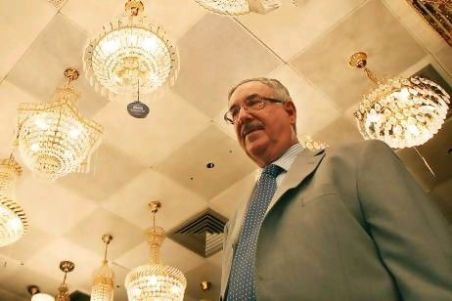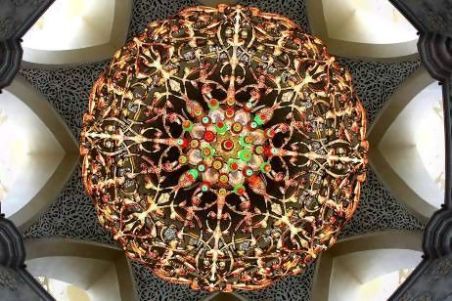An Abu Dhabi resident for over 40 years, Nasser Al Hajeb has not only watched the city develop, its fabric is the very story of his life reports Nick Leech

Pawan Singh, The National
At first glance, the Hamdan Street showroom of Crystal House Lights & Gifts seems a most unlikely venue for a conversation about anything other than crystal, lights and gifts.
Ornate mirrors, console tables, and light fittings line the walls, multicoloured crystal chandeliers hang low from the ceiling and tables are loaded with fine crockery, cutlery and delicate porcelain ornaments.
The shop may be decked in silk, gilt, and glass, but it is also home to a historical resource just as rare and invaluable to students of Abu Dhabi’s history as any official document in the National Centre for Documentation and Research.
That resource is Nasser Al Hajeb, the softly spoken, septuagenarian managing partner of Crystal House and an Abu Dhabi resident since 1968.
What sets him apart is not only his remarkable career – he worked on the construction of Abu Dhabi’s first Corniche, Mina Zayed, the existing Presidential Palace, and the Sheikh Zayed Grand Mosque – but the fact that he has recorded it all meticulously in diaries, files, photographs and fading press clippings that line the walls of his office.
The fabric of Mr Al Hajeb’s life in Abu Dhabi is the story of the city.
I was at university in Syria, and I was looking to improve my situation in life,” he said. “I couldn’t find a chance in Damascus, so I went to Kuwait. After a few months, I was asked to come to Abu Dhabi. I knew of Ras Al Khaimah from school but of Abu Dhabi, I knew nothing.”
Overnight, Mr Al Hajeb went from being an accountant with a Kuwaiti contracting company, Al Zamel & Darwish, to being their sole representative in Abu Dhabi.
“When I arrived, the airport was where the Al Ittihad offices are now,” he said. “From there to Al Hosn, the journey was maybe 45 minutes. There was only one road, you couldn’t drive fast because of the sand and you had to keep your car in a low gear.”
For a budding executive out to make a name and a new life for himself, Mr Al Hajeb’s beginnings were not auspicious. His first home was in a subdivided, single-storey, cinder-block building near the site of what is now the Hilton Corniche.
“When I arrived, the owner of the company came with me from Kuwait and after three days he said ‘Yalla! Go.’ I had expected a flat or maybe even a villa and a car but there was nothing,” he said. “I lived in one room. There was no kitchen and the water came from a tank outside and had to be filtered.”
There was also very little for Mr Al Hajeb to do but work. “There was no newspaper, no radio, nowhere to go. There was only one hotel, the Al Ain Palace, and that had only one floor and was always booked six months in advance.”
Given its scarcity at the time, it is perhaps not surprising that many of Mr Al Hajeb’s early memories of life in Abu Dhabi involve the availability and quality of fresh food.
“Until 1970, you couldn’t find fresh food in the market,” he said. “I used to send a boy who worked for me to queue at two companies who brought fresh fruit, vegetables and meat once a week from Lebanon. He stayed in the queue from six or seven o’clock in the morning and … had to wait until he got what I had written for him on a list. I wrote maybe 15 items – he would come back with four or five.”
Not long after his arrival, Mr Al Hajeb won his first major contract, to supply vehicles and excavators to the contractors building Abu Dhabi’s first Corniche. Another major contract soon followed when Al Zamel & Darwish was involved in the construction of the infrastructure for a new port, Mina Zayed.
“After some time, my company came to me and from a small company, in two or three years they found income and improvement,” he said. “We brought one vehicle from Kuwait and I made it nine. We had one excavator from Kuwait and I returned three.”
It was while Mr Al Hajeb was taking delivery of new vehicles that he had his first face-to-face meeting with Sheikh Zayed, an experience he would repeat several times, but one which he remembers vividly.
“His Highness Sheikh Zayed arrived to see a delivery of rice,” he said. “He said, ‘I am the President of this country and I have to make sure that everything is good for my citizens’. Sheikh Zayed asked, ‘From where are you coming?’ and used the Arabic word ‘akhouy’ – ‘my brother’. I knew it was His Highness Sheikh Zayed because I had seen him before on his way back from the harbour. He was driving his car himself.”
Soon after, Mr Al Hajeb made a decision that would alter the course of his life. He left the construction industry and went into business with an Emirati partner selling lighting, chandeliers, luxury wallpaper, porcelain, crystal, and gifts. His timing was opportune as oil revenues were finally starting to manifest themselves in the construction of new government ministries, palaces, houses, and mosques.
One of Mr Al Hajeb’s first public projects was supplying the lighting for what was then the new Sheikh Zayed bin Sultan Mosque on Airport Road, which still stands next to Etisalat headquarters.

Stephen Lock, The National
Little did he realise that 40 years later, he would also oversee the design and installation of all seven Swarovski crystal chandeliers in the Sheikh Zayed Grand Mosque. When the mosque opened, the centrepiece was reportedly the largest chandelier in the world.
When Mr Al Hajeb’s involvement with the project began in 1994, he had already supplied the chandeliers for the Presidential Palace, but nothing could compare to the stamina and effort required for the Grand Mosque.
“I used to drive to the site three or four times a week for six years,” he said. “If contractors were moving parts of the chandelier, I wanted to know, I was there. I was arranging everything and I needed to be satisfied that everything was going well.”
Mr Al Hajeb and an engineer even stayed in the mosque overnight before its opening in time for Eid Al Fitr in 2007. The next morning, Sheikh Khalifa, President of the UAE, and 20,000 other worshippers came for prayers.
Of all the projects Mr Al Hajeb has been involved with, his role in supplying the lighting for the Sheikh Zayed Grand Mosque is the work that makes him most proud.
“When I see the photos now of people praying under the chandelier during Ramadan, I feel like I made something,” he said.
“Before then, I had hoped to make something of my life and for me, this is the mosque. I saw the mosque, I saw the chandelier, and I thanked God for what had happened.”
When asked about the future, Mr Al Hajeb will not be drawn, but responds with a smile: “Our new projects are really something different. You would not believe what we are working on now. You can say that it would be strange to see these things.”
At the age of 70 and after all he has seen – a family business established, a city transformed and a nation built – Mr Al Hajeb’s next project must be spectacular indeed.
A version of this article originally appeared in The National, Abu Dhabi
